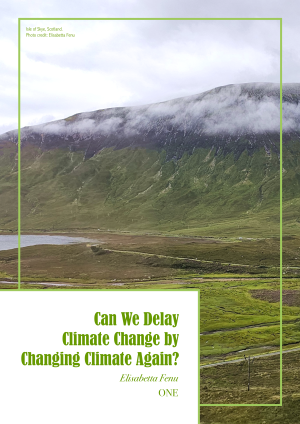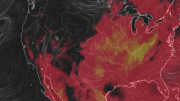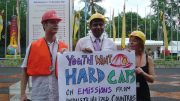 I kept looking out the bus window to try and catch a glimpse of the Old Man of Storr, a high pinnacle rock in the Isle of Skye. My tour guide was mortified — the fog made visibility extremely poor, and what would have been a scenic stop along the road, was a grey wall of nothing. At some point, the guide confessed, “I am very sorry. I wish I could change the weather and send the clouds away, but August in Scotland is unforgiving”.
I kept looking out the bus window to try and catch a glimpse of the Old Man of Storr, a high pinnacle rock in the Isle of Skye. My tour guide was mortified — the fog made visibility extremely poor, and what would have been a scenic stop along the road, was a grey wall of nothing. At some point, the guide confessed, “I am very sorry. I wish I could change the weather and send the clouds away, but August in Scotland is unforgiving”.
But even if you could change the weather, should you?
Since then, I’ve learnt a very important distinction: the one between weather modification, and geoengineering. The public is skeptical towards both, while the scientific community deems the latter a much more controversial practice — for a good reason.
Besides wild conspiracy theories, the public’s worries are legitimate when it comes to experiments with weather and/or climate. Between extreme weather events and ever more noticeable climate changes, people need stability.
Artificial rain
In April 2024, Dubai was hit by a huge flood, a rare event for the arid landscape of the United Arab Emirates (UAE). The blame was quickly put on UAE’s recent cloud seeding activity, a type of weather modification. Indeed, the UAE government developed a research program called the UAE Research Program for Rain Enhancement Science (UAEREP) and, since 2015, funds have been conceded to scientists to carry out various experiments. The goal of this program is to enhance rainfall, therefore tackling water scarcity in the country and, if the technology is promising enough, to implement it globally. It consists of firing salts and silver iodide crystals into the atmosphere, so that they can be used as condensation nuclei for the rain to form around. Thus, this process cannot form new clouds, it just acts as a fertilizer on existing clouds in the area. The new technology has been causing rainfall as intended (the study is still ongoing), however scientists unanimously agree that it wasn’t the cause of the 2024 flood. Cloud seeding’s impact is not enough to be able to destabilize weather on such a scale. The real culprit is something we know way too well: global warming. The scientific community still doesn’t know for certain if cloud seeding (or weather modification in general) can be harmful long term, but its regional, contained influence makes it so that it wouldn’t cause too much trouble if experiments were to go awry.
A change of climate
Climate modification, however, is another story. The proper term is geoengineering, and it features two categories: Carbon Dioxide Removal (CDR) and Solar Radiation Modification (SRM). The former is not as controversial, but some argue if it can really be inserted into the global market. It is the practice of removing carbon dioxide (CO2) from the atmosphere and storing it in (mostly) natural reservoirs to help reach “net zero” once we manage to significantly cut GHG emissions. It can — and will — be a good climate change mitigation strategy, although some methods are still too costly to be used worldwide and have a true impact. To reduce global warming, Solar Radiation Modification (SRM) aims to reflect sunlight away instead. A great idea in theory, but extremely hard to apply in the real world. The problematics that affect SRM are multiple: ethics, scale of experiments, research and capitalism. The most famous SRM method is called stratospheric aerosol injection (SAI), and it is also the most researched because scientists can already observe its effects by studying volcano eruptions. During explosive eruptions, volcanoes release a great quantity of sulfur dioxide (SO2) in the atmosphere, which turns into sulfate aerosols that reflect sunlight quite efficiently. In 1991, Mount Pinatubo violently erupted, injecting 17 million tonnes of SO2 into the stratosphere. A “volcanic winter” followed: so much sunlight was reflected that global temperatures decreased by 0.4 °C for about a year. The Mount Pinatubo eruption was the largest of the 20th century, and humans want to artificially recreate its effects. What could go wrong?
Just like weather modification, we still don’t know the consequences of long term SRM experiments. Problem is, conducting a global scale experiment is much more harmful and impactful than testing new technology in a confined area. A group of researchers tried to conduct a small-scale aerosol injection experiment in California but was later denied approval by the city council. Another well-known SMR technique is marine cloud brightening (MCB). Inspired by ship tracks, scientists want to increase the reflectivity of clouds over the sea by spraying sea water from boats themselves. Again, the idea is noble, but a study published on Nature Climate Change suggests that MCB can only bring local and temporary benefits, and it could even cause harm to the climate system after some years.
Experimentation with SAI seems like a dead-end road; even if researchers get the green light to conduct field research in limited areas, that wouldn’t provide enough data for a large-scale deployment. Computer models are encouraging, but they can’t be compared with the complexity of nature. We simply don’t know enough, and if we will at some point, it will be too late. If the goal of SRM is to delay global warming, its implementation can’t be slower than the global temperature deadlines we have set. Many worry that focusing too much on SRM could distract the scientific community from the actual solutions for decarbonization.
Lawless engineering
The scenario isn’t promising and, to make things worse, there is a complete lack of regulation regarding SMR deployment. Two entrepreneurs in the United States have already launched their private SMR small-scale experiment company, Make Sunsets, invading indigenous land in the process. Nobody can stop them, because there are no applicable laws. This news scared both the public and the scientific community, including geoengineering researchers. The technology isn’t good enough to be deployed, but a promise of salvation can easily be marketable, and whoever handles it doesn’t care if the practice is harmful or not. Once climate change activism enters the realm of global market and private owned companies, its priority falls behind profit.
An interview conducted by High Country News informed the Colfax-Todds Valley Consolidated Tribe about the sneaky experiments carried out by Make Sunsets over their land. The vice chair and lead cultural preservation officer of the tribe was undoubtedly worried, considering the tribe hadn’t been consulted, and there wasn’t much research about the experiments to begin with.
She said that these men are playing God, such manipulation of the elements shouldn’t be in our hands. Truthfully, humans have been playing God long before the rise of modern geoengineering — our biggest climate modification “experiment” has also been the most successful.
Elisabetta Fenu





